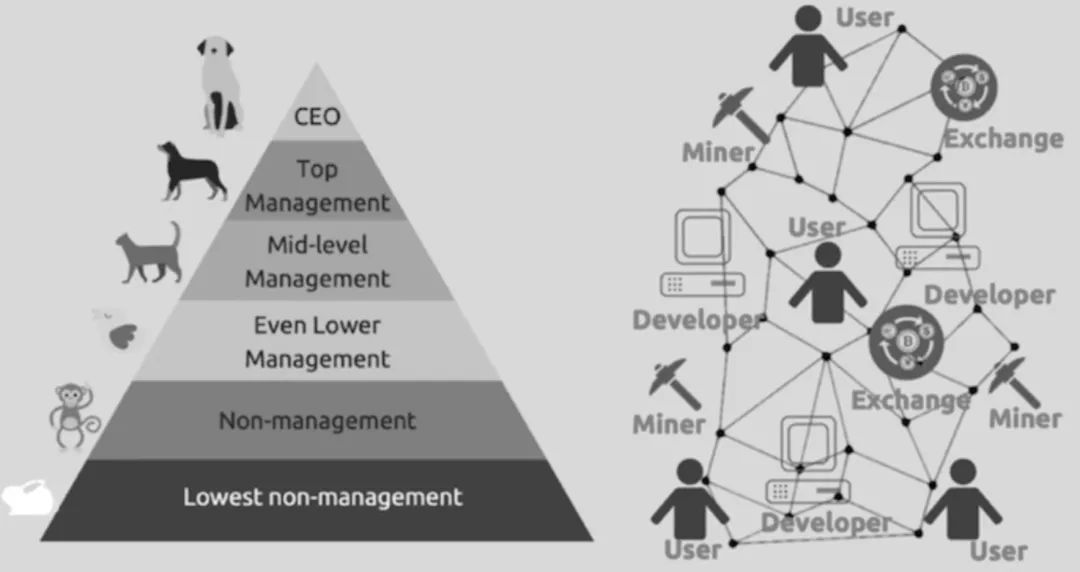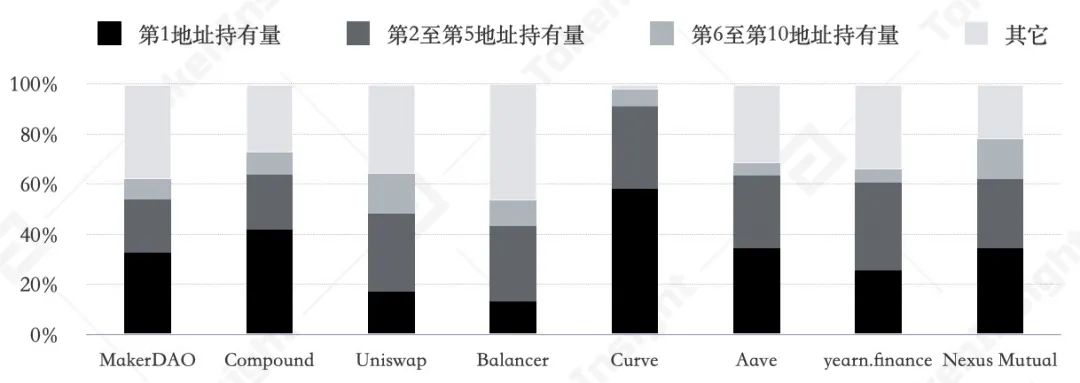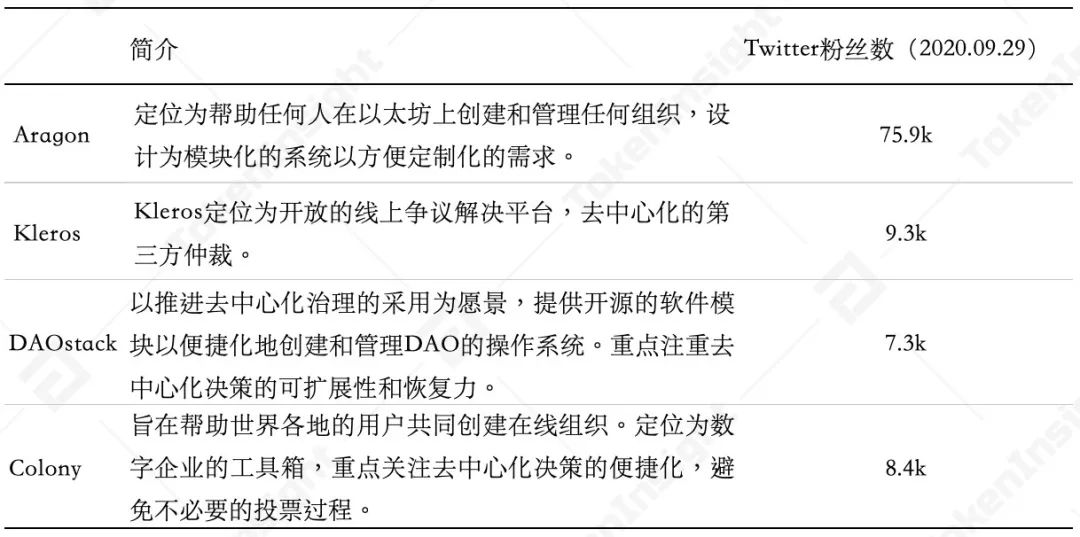foreword
While liquidity mining is detonating the DeFi market, there is also a steady stream of thinking about DAO in the industry. However, long before projects in the industry issued governance tokens one after another, DAO’s concept of decentralized governance is an important part of the decentralized attributes of the blockchain, which has triggered different projects to explore its implementation methods.
secondary title
1. What is DAO
The Bitcoin network achieves decentralization by allowing anyone to participate, and the system automatically operates according to the pre-set rules to complete the transaction process. At the same time, it coordinates the network through the consensus mechanism of the Proof of Work (PoW), so that the participants can reach a consensus, and Bitcoin currency as an economic incentive. The introduction of smart contracts has enabled DAO to have a clearer definition and clear implementation logic in the context of the blockchain—the rules are automatically executed through smart contracts after they are written into the blockchain. The creation of DAO thus becomes more convenient.

image description
Hierarchy Management VS DAO; Source: Smartz Platform Blog, Blockchainhub
However, despite its deep ties to the blockchain, the development of The DAO has not been all smooth sailing. Like many other DApps, an obvious problem faced by early DAOs was the security of smart contracts.
The DAO is the first DAO created on Ethereum. It is committed to providing a decentralized business model. The project accepts anyone to remit Ethereum to its address in exchange for project tokens, and token holders can Determine the investment plan for project funds. Essentially, The DAO is a decentralized management investment fund. The DAO received intense capital attention in 2016, but as a fault in The DAO smart contract was exploited by attackers, nearly 1/3 of the Ethereum was stolen. In order to recover this asset, Ethereum had to undergo a hard fork. And this incident also became the reason for the birth of Etheruem Classic.
After the carnival of the bull market in 2017 and the subsequent precipitation after the bear market, in June 2020, the liquidity mining launched by the DeFi lending project Compound detonated the market. Liquidity mining is to distribute the governance token (Governance Token) issued by the project to network participants who provide liquidity for the project. Governance token is an economic incentive for liquidity providers (LP) and also gives LP project governance authority symbol of. Mechanisms such as liquidity mining are themselves a manifestation of DAO implementation and application.
Compound opened the door for the rise of DeFi with liquidity mining. Before Compound, only a few projects in the DeFi field, including MakerDAO, issued governance tokens; after Compound, various DeFi projects began to issue governance tokens or gave projects native token governance rights. Mine gameplay emerges in endlessly.

image description
DeFi Governance Token Issuance Timeline; Source: TokenInsight


The distribution of governance tokens transfers project governance rights to participants to a certain extent, weakening the control of the core development team over the network. Participants can have the authority to manage projects by holding tokens or accepting entrustment, and depending on the project, the authority execution rules for each governance token are also different. The following table selects several typical DeFi projects to explain the authority of their governance tokens.
At the same time, the distribution of governance tokens of each project is also quite different. However, the address with the largest number of token holdings in multiple projects is marked as a governance mortgage address, and users can govern the project and share the fee income generated by the project by locking the token into the designated address. In several mainstream DeFi projects surveyed by TokenInsight Research, the token holdings of governance mortgage addresses accounted for 13%-33% of the total [2], showing the impact of the governance token model on decentralized participation .

image description
Distribution of DeFi Governance Tokens; Source: Etherscan, TokenInsight, 2020.09.28
However, the governance token model is only a step on the road to an idealized DAO, which improves the degree of decentralization compared to models managed by a designated foundation, but it is still controversial.
First of all, the governance token focuses on the decision-making rights on the chain and how the agreement itself will be implemented, and cannot cover all changes to the status of the project, such as the appointment of core team members. Second, many projects still use Admin Keys. Although the existence of the management key is to protect the interests of users in special and extreme situations, the management key can modify many contents of the protocol, which raises security concerns. In addition, the core team members of some projects hold a large number of governance tokens, and can entrust the voting rights of the tokens to third parties. The actual use of user governance token proposals and voting rights also varies from project to project. The ultimate purpose of many mining activities in the market is mainly to sell governance tokens in the secondary market.
[2] Does not include unmarked addresses
But at the same time, after The DAO incident, DAO projects such as Aragon, DAOstack, Colony, Kleros, etc. have been continuously launched in the industry. Such projects are generally built on Ethereum and are positioned to provide DAO infrastructure and construction tools. With the issuance of DeFi governance tokens, the demand for applications will increase.
secondary title
After the rise of DeFi, capital is eager to find the next growth point, and DAO and NFT have risen against the wind. DAO has won market attention along with the continued popularity of DeFi. Aragon, Kleros, DAOstack, and DXdao, as DAO projects that have issued native tokens, have experienced market value growth in July this year.

image description
Market value of DAO projects; sources: Coinmarketcap, Coingecko, TokenInsight
The design and positioning of DAO projects are diverse. As mentioned earlier, the issuance of governance tokens is a form of project creation of DAO. In addition to the DAO that focuses on empowering the development of a certain project, there is also a project like Moloch DAO3 that focuses on promoting the use of funds and the optimization of related infrastructure in Ethereum 2.0. On this basis, sovereign aggregates such as DXdao have been derived to carry out decentralized jurisdiction and empowerment for multiple independent projects.

2.1 Aragon
In contrast, the role of projects like Aragon, Kleros, DAOstack, and Colony is to provide the infrastructure and tools for the creation and management of DAOs. For example, DAOstack provides the underlying technical framework for DXdao; Aragon has helped many projects create DAOs, including mainstream DeFi and NFT projects, such as Aave, Curve, pNetwork, Decentraland, and Aavegotchi. The following table provides brief introductions and current community popularity of several DAO infrastructure and tools.
In terms of products and services, Aragon provides a wide range of solutions. Its Aragon Court service is a dispute resolution solution. At the same time, Aragon products include DAOs, a community DAO deployment solution, Connects, a DAO developer tool, and Agreements, a DAO protocol. Aragons modular deployment solution can make the development process of on-chain organizations convenient and efficient, which is one of the reasons why Aragon is widely adopted by many projects. As shown in the following three figures, in the statistics of DAO deployment on 79 platforms, 57% of the platforms have adopted DAO; at the same time, the number of proposals of platforms using Aragon to deploy DAO accounted for 51% of the total number of proposals of all projects. In addition, according to the measurement of voter participation on the DeepDao website, the average participation rate of all voters using the Aragon platform is 60%, while the average voter participation rate of all platforms is 49.6%.

image description
2.2 Kleros
Different from Aragons more macro focus scenarios, Kleros focuses on the resolution of organizational disputes. Simply put, it is a third-party decentralized arbitration court. Users can earn arbitration fees by acting as jurors, but jurors need to mortgage the platform token PNK, and the more mortgaged, the easier it is to be selected as jurors. At the same time, in order to ensure the honesty of jurors, jurors whose votes are inconsistent with the final arbitration results will not be able to obtain arbitration fees, and will also lose a certain amount of mortgage tokens. The figure below shows the number of daily disputes created on the Kleros platform, and there is an increasing trend from 2019 to the present. Similarly, Aragon provides such arbitration services through the Aragon Court.

image description
2.3 DAOstack
In addition to providing easy-to-use software modules for DAO governance, the biggest feature of DAOstack is that it focuses on the scalability of the decentralized decision-making process, improving decision-making efficiency without sacrificing decision-making quality, and promoting the large-scale development of group decision-making. To achieve this, DAOstack adopts a holographic consensus mechanism (Holographic Consensus), and the consensus is realized through the minority groups edge decision-making (Edge Decision). Specifically, users predict the importance of proposals by staking tokens. Correct prediction results will bring economic incentives to users, and wrong predictions will cause users to lose their mortgaged tokens. The purpose of this process is to screen out valuable proposals, so that voters attention does not need to be diverted by inferior proposals, thereby improving the efficiency of decision-making. In addition, DAOstack is a tool for creating and governing DAOs, and its infrastructure is shown in the figure below.

image description
DAOstack technical architecture; source: DAOstack white paper, TokenInsight
Although there are differences in implementation and positioning, DAO infrastructure and tool projects serve as the bottom layer of DAO, providing support for the effective operation and large-scale promotion of DAO.
To prevent illegal fund-raising activities under the banner of blockchain and virtual currency by various financial platforms, TokenInsight will strictly abide by national laws and regulatory regulations, and resolutely resist the use of blockchain for illegal fund-raising, network pyramid schemes, 1C0 and other Variations, dissemination of bad information and other illegal acts.
risk warning
To prevent illegal fund-raising activities under the banner of blockchain and virtual currency by various financial platforms, TokenInsight will strictly abide by national laws and regulatory regulations, and resolutely resist the use of blockchain for illegal fund-raising, network pyramid schemes, 1C0 and other Variations, dissemination of bad information and other illegal acts.
If you find that the content contains sensitive information, please contact us in the background, and we will deal with it in time.










